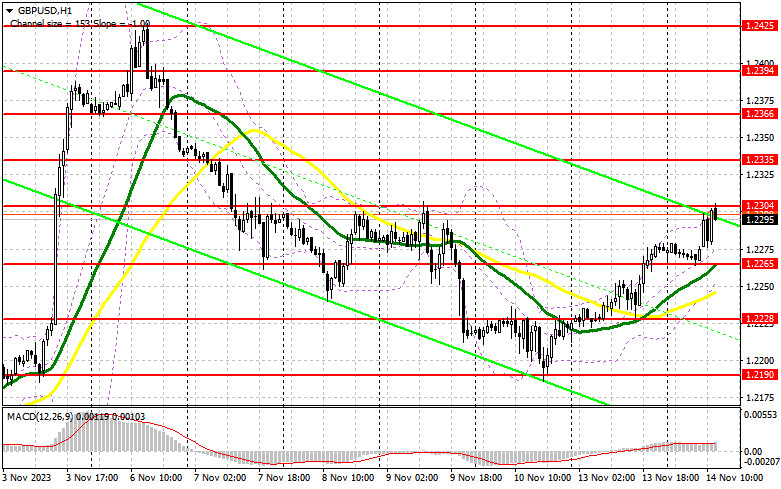
In my morning forecast, I drew attention to the level of 1.2304 and recommended making entry decisions based on it. Let's take a look at the 5-minute chart and analyze what happened. The rise and the formation of a false breakout at this level allowed for an entry point into short positions, but as of the time of writing this article, the pair had not experienced an active decline. The technical picture still needs to be revised for the second half of the day.

To open long positions on GBP/USD, the following is required:
The released data on the United Kingdom and the rise in average earnings supported the pound in the first half of the day. However, its further movement will entirely depend on the US Consumer Price Index, excluding food and energy prices. If the index remains unchanged or demonstrates a slower slowdown than expected, the pressure on the pound will likely return, leading to the realization of the morning selling signal. If inflation in the US continues to decrease actively, the pound may rise significantly. In the case of a decline in the pair, only the formation of a false breakout at 1.2265, where the moving averages are playing in favor of buyers, will provide an entry point for long positions with the aim of growth and another update of resistance at 1.2304, which was not surpassed in the first half of the day. Breaking through and consolidating above this range will lead to a new signal to open long positions with an exit at 1.2335. The ultimate target will be the area of 1.2366, where I will take profits. In the scenario of a decline in the pair and the absence of activity at 1.2265 from buyers in the second half of the day, pressure on the pair will increase significantly. In such a case, only a false breakout in the area of the next support at 1.2228, where the pound also rose well yesterday, will signal the opening of long positions. I plan to buy GBP/USD immediately on a rebound only from 1.2190 with the aim of a correction within the day in the 30-35 points range.
To open short positions on GBP/USD, the following is required:
Sellers need to defend the nearest resistance at 1.2304. If trading is below this range, pressure on the pair will persist. Another false breakout at 1.2304, similar to what I discussed above, will be an excellent option for opening short positions on the pound, counting on a significant downward movement after US data to support at 1.2265, formed at the end of yesterday, where the moving averages are, playing in favor of buyers. Breaking through and reverse testing from the bottom to the top of this range will deal a more serious blow to bullish positions, triggering stop orders and opening the way to 1.2228. The more distant target will be the area of 1.2190, where I will take profits. In the case of an increase in GBP/USD and the absence of activity at 1.2304 in the second half of the day, buyers will have a chance for further pair growth. In this case, I will postpone selling until a false breakout at 1.2335. If there is no downward movement, I will also sell GBP/USD immediately on a rebound from 1.2366, but only counting on a pair correction down by 30-35 points within the day.

Indicator signals:
Moving averages:
Trading is above the 30 and 50-day moving averages, indicating further pair growth.
Note: The author on the H1 chart determines the period and prices of moving averages and differs from the general definition of classic daily moving averages on the D1 chart.
Bollinger Bands:
In case of a decline, the lower boundary of the indicator at around 1.2250 will act as support.
Indicator Descriptions:
• Moving Average (MA) is an indicator that determines the current trend by smoothing volatility and noise. Period 50. Marked in yellow on the chart.
• Moving Average (MA) is an indicator that determines the current trend by smoothing volatility and noise. Period 30. Marked in green on the chart.
• Moving Average Convergence/Divergence (MACD) is a trend-following momentum indicator that shows the relationship between two moving averages of a security's price. Fast EMA period 12. Slow EMA period 26. SMA period 9.
• Bollinger Bands - a volatility indicator consisting of lines forming an envelope around the moving average. Period 20.
• Non-commercial traders - speculators such as individual traders, hedge funds, and large institutions using the futures market for speculative purposes and meeting certain requirements.
• Long non-commercial positions represent the total long open positions of non-commercial traders.
• Short non-commercial positions represent the total short open positions of non-commercial traders.
• The total non-commercial net position is the difference between non-commercial traders' short and long positions.